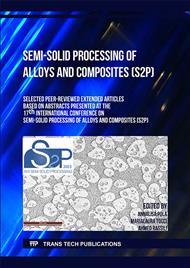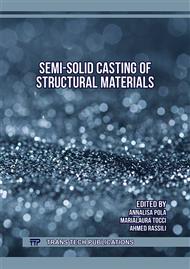p.107
p.115
p.121
p.127
p.135
p.141
p.147
p.157
p.165
Rheological Behavior in the Semisolid State of Al-Si-Cu Alloys Produced by ECAP
Abstract:
It is fundamental in thixoforming to have a refined microstructure that, when heated to the semisolid state, consists of a mixture of small spheres immersed in liquid as this ensures the best rheological properties. The present work therefore aims to analyze the rheological behaviour of aluminum-silicon-copper alloys, namely, Al5Si2.8Cu, Al6Si2.8Cu and Al7Si2.8Cu. The alloys were produced by conventional casting and then deformed by ECAP in one pass in a die containing two channels of the same cross-sectional area forming an angle of 120°. After being processed by ECAP, the alloys were heated to semisolid temperatures, i.e., temperatures corresponding to a solid fraction of 45 %, and kept in the semisolid state for 0, 30 and 90 s, after which they were subjected to hot compression tests. The structures of the three alloys had an excellent response to recovery and recrystallization mechanisms, with refined microstructures that led to the formation of very fine spheres immersed in liquid in the semisolid state. The best rheological behaviour was obtained for the Al5Si2.8Cu alloy, which had an apparent viscosity of the order of 103 Pa.s. The findings suggest that this simple ECAP process is a promising route for the production of semisolid feedstock for use in thixoforming.
Info:
Periodical:
Pages:
135-140
Citation:
Online since:
August 2023
Keywords:
Price:
Сopyright:
© 2023 Trans Tech Publications Ltd. All Rights Reserved
Share:
Citation:



